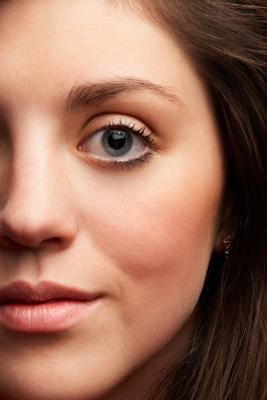Mineral makeup is a popular alternative to traditional cosmetics. Mineral makeup combines just a few natural ingredients to make foundations, concealers, blushes, eyeshadows and finishing powders. Most mineral cosmetics are gentle and well-tolerated, even on sensitive skin. Not all mineral makeup is created equally, and some products may contain potentially irritating ingredients or may not provide the coverage you need.
Types
Mineral makeup typically includes sericite mica, titanium dioxide, kaolin clay, magnesium stearate and mineral pigments. Corn starch or other simple filler ingredients may also be used. Bismuth oxychloride is included in some products, but it can also be a potential skin irritant. Eye shadows and liners are typically quite heavily pigmented, while skin-smoothing ingredients make up the bulk of foundation, concealer or blush.
Function
Mineral makeup foundations are available in a wide range of shades and varying levels of coverage, ranging from sheer to quite matte. Blushes and bronzers can add color, while concealer may help to even your complexion and disguise blemishes. Mineral eyeshadows come in colors ranging from matte, subtle neutrals to vivid shimmery shades. Whether you prefer a natural look or a more dramatic one, mineral makeup can help you create the perfect face.
Considerations
Mineral makeup is available from independent sellers, expensive cosmetic counter brands, mail-order sources and in your local drugstore. Drugstore mineral makeup may have a more limited range of shades and finishes than independent or more expensive brands, but it can be a good introduction to mineral makeup. Many small mineral makeup companies offer samples, allowing you to pick your perfect shade or test their products at a low cost.
Features
Whether you opt for a drugstore mineral makeup or purchase custom shades from an independent seller, good quality brushes are key. Mineral foundation and finishing powders require a very large, rounded makeup brush called a kabuki brush. Smaller brushes are appropriate for eyeshadow and concealer. As an alternative to applying your mineral foundation with a brush, mix a small amount with your usual moisturizer for a light and sheer tinted moisturizer application.
Warning
You can determine the quality of mineral makeup by reading the ingredient list. You should avoid chemical ingredients, like dimethicone or silica, but also irritating minerals, like bismuth oxychloride. Look for artificial ingredients, including parabens, dimethicone, silica, bismuth oxychloride, or micronized ingredients. If you notice redness, itching or irritation after using your mineral makeup, discontinue use.





